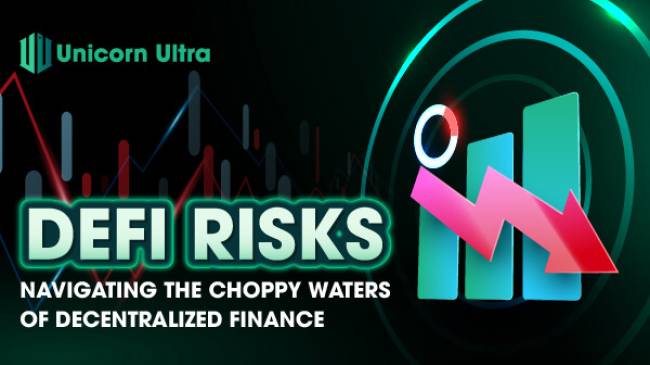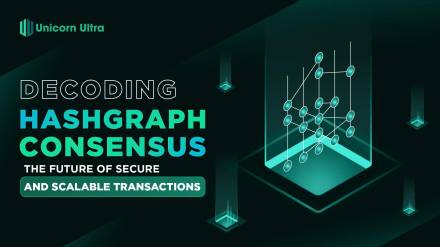In this article, let's delve into some of the prominent risks associated with DeFi platforms with Unicorn Ultra, shedding light on the vulnerabilities that could jeopardize investments. By understanding these DeFi risks, investors can make more informed decisions and adopt strategies to safeguard their funds.
Table of Contents
Software Risk in DeFi
DeFi protocols function as internet-based software applications, typically with minimal human oversight and often handling substantial sums of money. Like all software, DeFi protocols are susceptible to two primary software risks: coding errors, referred to as "bugs," which can lead to operational malfunctions, and security vulnerabilities that may permit unauthorized access and fund theft by malicious actors.

Eliminating Software Risk entirely in DeFi investments is impossible; however, there are strategies to mitigate it. New DeFi protocols may offer extraordinarily high investment returns, sometimes reaching 1,000% or 2,000%. While these returns may be tempting, it's important to remember that higher returns often come with increased risk.
Generally, DeFi protocols with a longer operational history and larger deposit volumes tend to have lower Software Risk compared to newer or smaller protocols. This analogy can be likened to a new car model; it takes time for engineers to iron out issues. Established DeFi protocols have had more time to identify and rectify software problems, making them more secure. Additionally, larger protocols are more likely to be targeted by hackers than smaller ones. Assuming larger protocols face frequent hacking attempts, if they have maintained security over an extended period, it suggests robust software security.
Before investing in a DeFi protocol, it's essential to research its operational history and total deposits. You can also examine its efforts to minimize Software Risk, such as conducting code audits by independent security firms and offering bug bounties. Searching for news reports about any prior hacks can provide valuable insights.
If a protocol has experienced a security breach, investigate the incident's timing, the response of the protocol's operators, and the measures taken to prevent future breaches. This information can guide your decision on whether to entrust your funds to the protocol.
To reiterate, there is no DeFi investment devoid of Software Risk, but these considerations can help assess the magnitude of Software Risk associated with a specific DeFi protocol.
Counterparty Risk in DeFi
In any lending arrangement, whether within or outside the DeFi ecosystem, there exists a counterparty risk, which pertains to the possibility of lending funds to a borrower who may not fulfill their repayment obligations. Many prominent DeFi lending protocols, including Aave, Compound, and Maker, implement a requirement for borrowers to over-collateralize their loans. This means that borrowers must provide collateral valued at more than 100% of the borrowed amount.
Prior to committing your funds to a DeFi lending protocol, it is imperative to comprehend the identity of the borrower and the collateralization process employed. Questions such as the proportion of collateral that borrowers can withdraw, the types of assets acceptable as collateral, and the conditions leading to collateral liquidation should be thoroughly addressed. These fundamental inquiries should be posed before depositing your assets into a DeFi lending protocol.
Token Risk in DeFi

Every DeFi investment includes a range of cryptocurrency tokens. It's crucial to dedicate time to researching each of these tokens. Consider factors such as the duration of their trading history, the reputation of the organizations behind their creation, and, if backed by reserves, the nature of those reserves and their investment locations. Each token within your DeFi investment has unique attributes and associated risks. Make sure to conduct a comprehensive investigation to understand these characteristics thoroughly.
Regulatory Risk in DeFi
Presently, DeFi protocols function with minimal government oversight or regulation from any official authority. To put it simply, this scenario has the potential to evolve, and the impact of potential government regulations on DeFi protocols remains uncertain, making it impossible to predict how such regulations might influence your DeFi investments.
Impermanent Loss in DeFi
Decentralized exchanges (DEXs) determine token prices within a liquidity pool differently than their counterparts in the open market. When tokens in a liquidity pool experience disparate price fluctuations—for instance, one token undergoes rapid value changes while the other remains relatively stable—the DEX recalibrates the token values in the pool. This recalibration typically results in the tokens within the pool being worth less than their market counterparts. Despite earning rewards from the DeFi protocol for depositing tokens into the liquidity pool, you might find yourself in a scenario where holding the tokens would have yielded greater profits compared to depositing them.
Cryptocurrency markets are renowned for their volatility, making it challenging to predict the future price movements of any two cryptocurrencies or the rates at which they may change. Nonetheless, you can explore the internet for an impermanent loss calculator to conduct a retrospective analysis, known as a "backtest," using historical data. This backtest provides insights into how your investment would have performed based on past data.
It's crucial to note that cryptocurrency prices are highly volatile, and past performance doesn't necessarily forecast future returns. Nevertheless, this backtest offers historical information on the behavior of the tokens in your pool. You can examine factors like price correlation and which token tends to fluctuate more rapidly. Keep in mind that newer tokens might have limited historical price data, which should be factored into your risk assessment for a particular investment.
One effective method to mitigate impermanent loss in your DeFi investments is to participate in liquidity pools containing only one token. In such pools, the absence of multiple tokens eliminates the potential for divergent price fluctuations that could result in impermanent loss.
Impermanent loss can be intricate and challenging to compute, but these considerations aim to help you evaluate it without feeling overwhelmed by its complexity.
Gas Fees in DeFi

Although DeFi protocols are now compatible with various blockchains, some of which boast minimal transaction costs, the majority of major DeFi protocols operate on the Ethereum network. Unfortunately, Ethereum's transaction fees, known as "gas fees," can be quite substantial when depositing funds into a DeFi protocol. This is particularly evident when your DeFi investment involves multiple steps, as is often the case. It's crucial to assess whether gas fees could potentially exceed your anticipated investment gains. For instance, if you expect a 10% annual return on an investment, and your gas fee amounts to 10% of the investment, it would take an entire year just to break even.
While investing in DeFi is undoubtedly enticing and gas fees can be frustrating, it's essential not to allow these fees to erode your prospective investment returns.
Outwitting Oneself in DeFi
In essence, cryptocurrency investing can be likened to investing in commodities, which is inherently intricate. DeFi protocols and blockchain technology also introduce complexities of their own. Furthermore, most traditional commodities, such as gold and oil, have been in existence for centuries, with commodity markets having a history spanning at least a century. In stark contrast, cryptocurrency is a relatively new phenomenon, only about a decade old, and DeFi only gained significant popularity in 2020.
Hence, investing in DeFi protocols isn't just complex; it's also a novel frontier. Consequently, even if you believe you comprehend the known risks associated with DeFi engagement, you still remain unaware of the unforeseen risks in DeFi investing that may emerge in the future. It's essential to bear in mind that while more intricate DeFi investments might seem enticing or promise higher rewards, they can also be more challenging to grasp and carry greater risk.
If you're already involved in DeFi investing or contemplating it, you're inherently at the forefront of commodities and technology investing. Avoid pushing yourself beyond your comprehension or your comfort zone regarding investment risk. You can commence with simpler DeFi investments, such as single-token pools, and gradually progress to more complex strategies as you acquire knowledge and experience. Starting with modest investments and expanding your DeFi portfolio based on performance observations is a prudent approach. Refrain from outsmarting yourself by attempting to undertake too much too rapidly.
Conclusion
While decentralized finance holds immense potential, it comes with its share of risks. However, with careful research, DeFi risks management, and adherence to best practices, investors can better protect their assets and contribute to the growth and maturation of the DeFi space.






